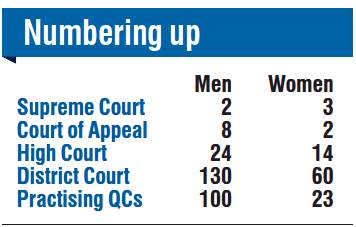
The New Zealand Law Society said earlier this week there were now 6553 women practising in the country - three more than their male counterparts.
President Kathryn Beck said she was "thrilled" with the landmark, which had been coming since the 1990s, when female law graduates exceeded males.
Though the watershed was pleasing, experienced Dunedin barrister Anne Stevens said it should not act as a smokescreen for serious problems within the profession.
"I can’t believe we still discuss pay equity in this day and age. I just shake my head," she said.
"I haven’t seen much change in 30 years of practice."
Mrs Stevens said the gender disparity was also apparent in the make-up of the judiciary.
It is only the Supreme Court where women outnumber men.
In the Court of Appeal and High Court, the balance is heavily skewed towards male judges and 130 of the 190 District Court judges around the country are men.
"Don’t tell me there aren’t an equal number of good women to take a job on the bench," Mrs Stevens said.
Figures for Queen’s Counsel are even more unbalanced. Only 23 of 123 currently practising are women.
Otago Women Lawyers’ Society convener Ruth Ballantyne said she was delighted by the recent news and noted that in the region the number of female practitioners exceeded males last year.
"It’s a wonderful time to celebrate but there’s still a lot more to be done," she said.
Ms Ballantyne pointed to the number of female judges and QCs as being particularly concerning.
Last year marked 120 years since Dunedin woman Ethel Benjamin became the first woman in the country to act as counsel in court.
When viewed against that, Ms Ballantyne said, it was remarkable how much things had changed.
However, looking at the "traditional measures" of success, the picture was not so rosy.
The three large Dunedin law firms - Anderson Lloyd, Gallaway Cook Allan and Downie Stewart - all have more male partners than females.
All of Downie Stewart’s five partners are men.Partner Gerard DeCourcy called it "more of an accident than anything else", which might look significantly different in a decade.
He denied any suggestion of an "old boys’ club" in operation.
"I don’t think that’s true at all," Mr DeCourcy said.
He said the opposite was in fact the case, and succession planning was a real focus at the firm.
Gallaway Cook Allan chief executive Matt Gorman said five of the company’s 12 partners were women, which he said was a result of simply employing the best candidate.
"A while ago we were male-dominated. Now the balance is much healthier," he said.
"It’s hard to say it’s a conscious effort but as a firm we are very aware of imbalance at senior ranks and that guides us, to an extent."
Mr Gorman said he had worked at big law firms around the world and did not see any evidence of ingrained sexism here.
Both Mrs Stevens and Ms Ballantyne agreed partnership at law firms was an increasingly archaic tool for measuring success.
Many women opted for work-life balance or independence over committing all their time to a company, Ms Ballantyne said.
The New Zealand Law Society will soon introduce the "gender equality charter".
"[It] is about all of the legal profession making a voluntary commitment to meeting a series of equality objectives to ensure that women lawyers, whether full time or part time, are given the same opportunities as men to reach senior levels in the legal profession," Ms Beck said.
"We can and we will do better."













